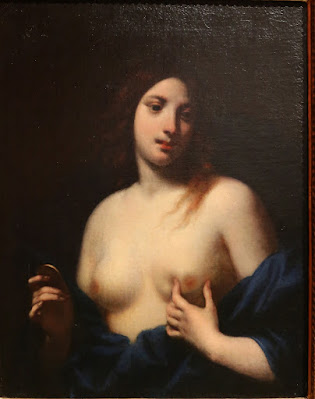 |
| Piero del Pollaiuolo Personification of Faith ca. 1470 tempera on panel Galleria degli Uffizi, Florence |
 |
| Sandro Botticelli Personification of Fortitude ca. 1470 tempera on panel Galleria degli Uffizi, Florence |
 |
| Maso da San Friano Personification of Fortitude ca. 1560-62 oil on panel Galleria dell' Accademia, Florence |
 |
| Dosso Dossi Personification of Wisdom (detail) before 1542 oil on canvas Palazzo dei Diamanti, Ferrara |
 |
| Battista di Domenico Lorenzi Personification of Sculpture ca. 1564-74 marble Tomb of Michelangelo Basilica di Santa Croce, Florence |
 |
| Lorenzo Sabatini Personification of Geometry before 1576 oil on canvas Galleria Sabauda, Turin |
 |
| Giovanni Martinelli Personification of Geometry before 1659 oil on canvas private collection |
 |
| Francesco Morandini (Il Poppi) Personification of Justice ca. 1582-85 oil on canvas private collection |
 |
| Francesco Furini and workshop Personification of Avarice ca. 1630-40 oil on canvas Galleria degli Uffizi, Florence |
 |
| Cesare Dandini Personification of Intelligence before 1657 oil on canvas private collection |
"The symbols we derive from antiquity may provoke a regression to that pagan mentality to which they owe their origins, but they may also help us to achieve what he [Aby Warburg] called orientation, in other words they can serve as instruments of enlightenment. . . . Now if there is one element in the classical tradition which allows us to probe this view it is the habit of Personification. I need not enlarge on the ubiquity of this habit in the period under discussion for it is as familiar to historians of literature as it is to historians of art. In fact, it seems to me sometimes that it is too familiar; we tend to take it for granted rather than to ask questions about this extraordinary predominantly feminine population which greets us from the porches of cathedrals, crowds around our public monuments, marks our coins and our banknotes, and turns up in our cartoons and our posters; these females variously attired, of course, came to life on the medieval stage, they greeted the Prince on his entry into a city, they were invoked in innumerable speeches, they quarrelled or embraced in endless epics where they struggled for the soul of the hero or set the action going, and when the medieval versifier went out on one fine spring morning and lay down on a grassy bank, one of these ladies rarely failed to appear to him in his sleep and to explain her own nature to him in any number of lines. . . . The natural dwelling place of personifications, if I may personify them in this way, is in the house of Art. Art in our period is certainly conventional rather than spontaneous. It relies on precedence and this precedence points aback to antiquity. If we ask what it was that led to the marriage between poetry and personification the true answer lies hardly on the purely intellectual plane. It lies less in the invention of suitable defining attributes than in the attraction of psychological and physiognomic characterisation. In describing Envy in her cave Ovid could make us visualise the evil hag who is Envy personified. To be sure she has a serpent as her attribute but the character and feeling tone of such a creation extends far beyond the features which can be distinctly enumerated. Artistic characterisation differs from rational definition in that it creates symbols rather than signs. What I mean is that the artistic personification is inexhaustible to rational analysis. It is to this that it owes what might be called its vitality or simply its vividness. While we are under its spell we are unlikely to ask whether such a creature really exists or is merely a figment of the artist's imagination. And thus the arts of poetry, of painting and sculpture, of drama and even of rhetoric aided by tradition can continue the functions of mythopoeic thought."
– E.H. Gombrich, from the essay Personification, published in Classical Influences on European Culture, edited by R.R. Bolgar (Cambridge University Press, 1971)
 |
| Carlo Dolci Allegory of Charity ca. 1659 oil on canvas Palazzo Pretorio, Prato |
 |
| Antonio Corradini Personification of Faith ca. 1717-20 marble Grand Palais, Paris |
 |
| Anton Raphael Mengs Personification of Pleasure ca. 1754 pastel on paper, mounted on canvas Metropolitan Museum of Art, New York |
 |
| Angelica Kauffmann Self Portrait as Personification of Hope ca. 1790 oil on canvas Accademia di San Luca, Rome |
 |
| Alfred Agache Personification of Vanity 1885 oil on canvas Palais des Beaux-Arts de Lille |